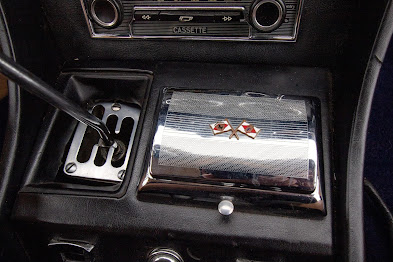Cruise (pronounced krooz)
(1) To sail about on a pleasure trip (often as
cruising).
(2) To sail about, as a warship patrolling a body
of water.
(3) To travel about without a particular purpose
or destination.
(4) To fly, drive, or sail at a constant speed
that permits maximum operating efficiency for sustained travel.
(5) In aeronautics,
the portion of aircraft travel at a constant airspeed and altitude between
ascent and descent phases.
(6) To travel at a moderately fast, easily
controllable speed.
(7) To travel about slowly, looking for customers
or for something demanding attention.
(8) As cruise missile, an intermediate-range
weapon.
(9) Among male homosexuals, actively to seek a casual
sexual partner by moving about a particular area known to be frequented by
those there for such purposes, an area known to be productive known as “cruisy”
(“to troll” & “trolling” were once used as a synonyms but those terms have
now been claimed by their use on the internet).
(10) In informal use in the US military, a period spent in the
Marine Corps.
(11)
In casual use in sporting competition, easily to win.
1645-1655:
From the Dutch kruisen (to
cross, sail to and fro), from kruis
or cruis (cross), from the Middle
Dutch cruce, from the Latin
crux. Root was the primitive
Indo-European sker (to turn, to
bend); etymologists suggest it may be cognate with the Latin circus (circle) and curvus (curve). In English,
it began to be used as a noun in 1706 in the sense of “a voyage taken in
courses” and by 1906 as “a voyage taken by tourists on a ship". It was related to the French croiser (to cross, cruise), the Spanish cruzar and the German kreuzen. The alternative spelling cruize
is obsolete. Cruise & cruising are
nouns & verbs, cruised is a verb, cruiser is a noun and cruisy is an
adjective; the noun plural is cruises.
Cruiser
in the sense of "one who or that which cruises"(agent noun
from the verb cruise) is from the 1670s, probably, borrowed from similar words
in continental languages (such as the Dutch cruiser & French croiseur). In older use, a cruiser was a warship built
to patrol and protect commerce of the state to which it belongs and to chase
hostile ships; cruisers were the classic gun boats used by the European
colonial powers for patrolling their empires.
In this use they were often compared to the frigates of old in that they
possessed good speed and were employed to protect the trade-routes, to glean
intelligence, and to act as the “eyes of the fleet” and in casual use, during
the eighteenth century, the term was often applied to the ships of privateers
(pirates). Cruiser was used to describe
homosexuals “cruising for sex partners" (ie frequenting and lingering in
places well-known for such things) from 1903, as a boxing weight
(cruiserweight) class, from 1920. The
meaning "police patrol car" is a 1929 adoption of American English.
Royal Navy battlecruiser HMS Hood entering Valletta harbor, Malta 1937.
In admiralty use, cruisers are now the largest of
the conventional warships still in service.
Navies used to use the term “cruiser” more as a description of the tasks
for which the ships were used rather than specific nature of the construction,
the early cruisers those ships which were used for long-range missions such as costal
raiding or scouting and it was only in the late nineteenth century as the
fleets grew and became more specialized that the classic model of the corvette
/ frigate / destroyer / cruiser / battleship evolved. Even then there were distinctions such as light
& heavy cruisers but the most interesting development in warship
architecture was the battlecruiser, built essentially because the Dreadnought
had created “a gap in the market”. Battlecruisers
were battleships with less armor, therefore gaining speed at the cost of
greater vulnerability. The theory was
they would have the firepower to out-gun all but the battleships and those they
could out-run with their greater speed.
The concept seemed sound and in December 1914, at the Battle of the
Falkland Islands, two Royal Navy battlecruisers vindicated the theory when they
chased and destroyed the German East Asia Squadron. However, in 1916, the
performance of the battlecruisers in the Jutland engagement forced the
Admiralty to re-consider. Jutland was
the closest thing to the great battle of the fleets which had been anticipated
for decades but proved anti-climatic, both sides ultimately choosing to avoid
the decisive encounter which offered the chance of victory or defeat. What it did prove was that the naval
theorists had been right; the battlecruiser could not fight the battleship and
if their paths threatened to cross, the less-armored vessel should retreat and
rely on greater speed to make good her escape.
There were technical deficiencies in the British ships, without which
perhaps three of their battlecruisers wouldn’t have been lost, but what
happened at Jutland made it clear to the admirals that uneven contests between
the big capital ships were to be avoided.
The consequence was that the battlecruiser became unfashionable and
after the round of disarmament in the 1920s, none were built until,
unexpectedly, the Soviet Navy commissioned four in the 1980s. They proved the last of the breed.
Origin of cruise missiles
US Pershing II cruise missiles in Neu-Ulm military base, Swabia, Bavaria in the then Federal Republic of Germany (The FRG, the old West Germany), 1984.
Carrying large warheads long distances, cruise
missiles are guided weapons, used against ground targets; they fly at both
subsonic and supersonic speed, remain in the atmosphere and, self-propelled for
the most of their flight, travel for mostly at a constant speed. In this they differ from ballistic missiles which
fly in an arc, often reaching suborbital flight with a final trajectory much
like a bullet because, once the fuel is expended, the path from that point is determined
by the speed and direction of launch and the force of gravity pulling towards
Earth. Both cruise and ballistic
missiles can carry nuclear warheads but cruise missiles are most often equipped
with conventional warheads. Theorists
and researchers were exploring the possibility of military missiles as early as
1908, described then as the aerial torpedo,
envisaged as remote-controlled weapons with which to shoot-down airships
bombing London, perceived then as the most credible airborne delivery
system. . Between the first and second world wars, the
major powers all devoted resources to research but few projects reached even
the prototype stage.
Annotated schematic of the V-1 (left) and a British Military Intelligence drawing (dated 16 June 1944, 3 days after the first V-1 attacks on London (right).
First deployed in 1944 the German Vergeltungswaffen eins (“retaliatory weapon 1” or "reprisal weapon 1” and eventually known as the V-1) was the world’s first cruise missile. One of the rare machines to use a pulse-jet, it emitted such a distinctive sound that those at whom it was aimed nicknamed it the “buzz-bomb” although it attracted other names including “flying bomb” and “doodlebug”. In Germany, before Dr Joseph Goebbels (1897–1945; Reich Minister of Propaganda 1933-1945) decided it was the V-1, the official military code name was Fi 103 (The Fi stood for Fieseler, the original builder of the airframe and most famous for their classic Storch (Stork), short take-off & landing (STOL) aircraft) but there were also the code-names Maikäfer (maybug) & Kirschkern (cherry stone). While the Allied defenses against the V-1 did improve over time, it was only the destruction of the launch sites and the occupation of territory within launch range that ceased the attacks. Until then, the V-1 remained a highly effective terror weapon but, like the V-2 and so much of the German armaments effort, bureaucratic empire-building and political intrigue compromised the efficiency of the project.
Lindsay Lohan on a cruise in the Maldives, January 2019.
The V-1 used a gyroscope guidance system and was fitted with an unusual triple-layer fuse system, the primary device and a backup augmented by a fail-safe designed to ensure destruction of “duds” (weapons which fail to detonate) so they couldn’t be examined. The accuracy of the thing was sufficient only for use against very large targets (such as the general area of a city which made sprawling London ideal) while the range of 250 km (155 miles) was significantly less than that of a medium bomber carrying the same payload. The main advantages were speed (although not sufficient to outrun the fastest of the low-altitude propeller-driven interceptors), expendability and economy of operation. Indeed, it was probably the war’s outstanding delivery system in terms of cost per ton of explosive, able to carry a warhead of 850 kg (1,870 lb) to London at a tiny fraction of the cost of using manned aircraft for the same task with the priceless additional benefit of not risking the loss of aircrew. The production cost of a V-1 was also only a small fraction of that of the supersonic V-2 ballistic missile which carried a warhead only of a similar-size although once launched, it was effectively invulnerable. Unlike the V-2, the initial deployments of the V-1 required large, fixed launch ramps which were relatively easy to detect and susceptible to bombardment. Later experiments produced much smaller launch facilities which provided for a greater rate of sustained fire. Bomber-launched variants of the V-1 saw limited operational service near the end of the war, with the pioneering V-1's design reverse-engineered by the Americans as the Republic-Ford JB-2 cruise missile.
Luftwaffe Mistel Aircraft ( Focke-Wulf Fw 190 (upper) & Junkers Ju 88 (lower), Merseburg, Germany, 1945.
The "cruise missile" project
which was the best example of the improvisation which characterized much of the
ad-hoc weapon development of war time was the Mistel (mistletoe) or Beethoven-Gerät (Beethoven
Device) composite
aircraft program which the Germans developed in 1943. It was a rudimentary air-launched cruise
missile, made by a piloted fighter aircraft being mounted atop an unpiloted
bomber-sized aircraft, packed with explosives and the larger aircraft would be released
to glide towards the target. Calling it
the mistletoe reveals a sense of humor mot usually associated with the
Luftwaffe but it was known rather more evocatively as the Vati und Sohn (Daddy and Son) or the Huckepack (Piggyback). Although built in the hundreds, by the time
it was available for deployment, the scope for attacking large targets with
manned aircraft had reduced and the need was for precision delivery, something
for which the Mistel was ill-suited and success was
limited.



























